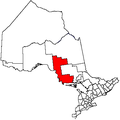Obadjiwan 15E | |
|---|---|
| Obadjiwan Indian Reserve No. 15E | |
| Coordinates: 46°53.5′N84°37′W / 46.8917°N 84.617°W | |
| Country | |
| Province | |
| District | Algoma |
| First Nation | Batchewana |
| Area | |
| • Land | 0.68 km2 (0.26 sq mi) |
| Time zone | UTC-5 (EST) |
| • Summer (DST) | UTC-4 (EDT) |
| Website | www.batchewana.ca |
Obadjiwan 15E is a First Nations reserve in Algoma District, Ontario. It consists of two non-contiguous parcels of land on Batchewana Bay (Lake Superior), and is one of the reserves of the Batchewana First Nation.

